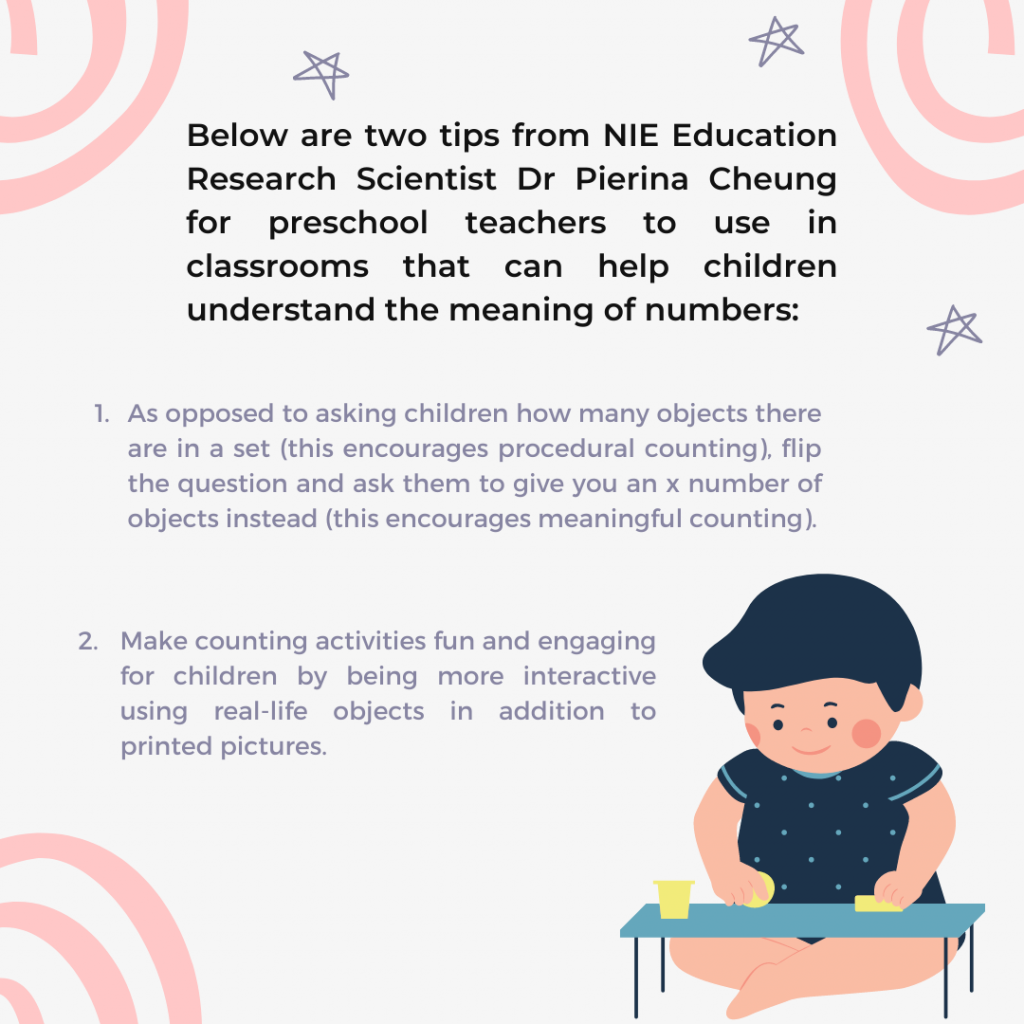Why Singapore’s English Teachers Should Embrace Singlish, Not Fight It
Is it time for Singaporean educators to embrace Singlish as a legitimate learning tool? What the Research […]
Read More
What does it mean to children when they learn number words such as one to 10? What is the extent of their understanding of the meaning behind those words? At which stage of learning do they begin to understand the association of number words to its actual quantity? Dr Pierina Cheung, Education Research Scientist from the Centre for Research in Child Development at NIE, shares with us her research study that aims to explore the answers to these questions as well as to identify the factors that may facilitate children’s numeracy learning process.

Over the last 15 years, Pierina has conducted extensive research in early childhood education in the United States, Canada and Singapore, with a large portion of it dedicated to numeracy development in children.
In her most recently concluded NIE research study titled “Improving Early Number Word Learning: Examining the Role of Input”, she sought to find out how children understand the meaning of number words, the factors that might predict their understanding, as well as ways that teachers could use to help children attain that understanding.
Young children can often start counting from one to five or six. “However, this does not necessarily mean they understand the meaning behind those number words,” Pierina shares. “To learn counting, children have to learn the procedures and also how counting relates to the meaning of number words. The procedural aspects refer to the regurgitation of number words and the tagging of objects with number words. Children can perform the procedures without actually understanding what counting means.”
This inspired Pierina to explore at a deeper level when and how children start to learn the meaning of counting. To do so, her research study integrates various games with instructional tasks for children aged two to four.
“What we found interesting was that when children learn number words with objects as reference, they develop a learning pattern where they learn the first few numbers (one to four) individually. Subsequently, they figure out the rest of the number words up to 10 to some extent,” Pierina explains. “There seems to be a shift after learning four, and it also takes around 1 to 3 years for them to fully understand the meaning of number words.”
“The use of different examples helps children learn number word meanings. [Teachers] can use whatever they have around them to create fun, meaningful counting contexts for their children.”
– Pierina, on how to make counting fun for children
Pierina shares that it is common for young children to give inconsistent results when asked to give a particular quantity. For example, when asked to feed a puppet two bananas, they may sometimes give two, three or even four.
“This shows that they do not have a stable understanding of number words yet, and we try to train these children on individual numbers in a chronological order to help them realize their meaning,” Pierina explains. In her study, she showed young children different groups of objects that differ on various physical properties such as colour, size and shape. For example, to help children learn three, they showed them three purple buttons, three green buttons, three orange toy houses and so on.
“The use of different examples helps children learn number word meanings,” Pierina shares. “Teachers can also apply this at school. The classroom is full of interesting objects. They can use whatever they have around them to create fun, meaningful counting contexts for their children. Sometimes, providing enriched input in a preschool classroom is about opening your eyes to see what is available around you, making observations, and providing immediate feedback.”
Due to the varying levels of understanding of number words among children within a class, Pierina stresses that it becomes important for teachers to recognize and acknowledge the individual differences so they can tailor to each child’s learning pace.
“Studying young children is not an easy task. You can’t always ask them what they think and their attention span is relatively short, so as researchers, we really need to be creative with how we present the materials to get at what they think about the world,” Pierina explains.
However, as challenging as it is, it is also the most fulfilling aspect of her research. “What’s more exciting and rewarding than understanding how learning unfolds in development and sharing that knowledge with teachers and parents?”
Sharing research findings with preschool teachers can be challenging, Pierina adds. “Teachers may not know the distinction between learning counting procedures and the meaning of counting, but over time, as we hear more about what they experience in the classroom, we are better at helping them connect their own observations with research findings. Now when I share research on counting, I often see the light bulb goes on in their eyes.”
Despite being in the field for 15 years, Pierina shares that there are a lot more questions to be asked, findings to be discovered, as well as other variables to deep dive into such as bilingual number learning, the relationship between language and number, and shared book reading in numeracy.
Unlike number words, young children learn other types of words such as words for objects, people, properties of things, or actions at a much quicker pace. Children pick up nouns easier because they have a clear reference.
“You can see and touch a car or a ball, and you can see properties such as big or yellow. Numbers are an abstract concept like time,” Pierina explains. “However, one can still infer time from perceptual features such as the brightness or darkness of the day. Numbers don’t have that type of perceptual cue. That’s one reason why it takes children so much longer to learn numbers than other types of words.”
